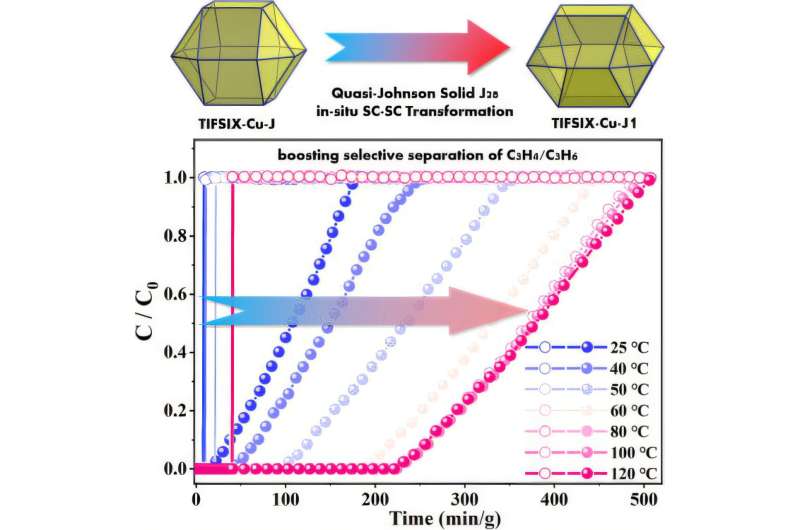Science
Researchers Develop Innovative Fluorinated Framework for Gas Separation

A research team from the Fujian Institute of Research on the Structure of Matter, part of the Chinese Academy of Sciences, has synthesized a groundbreaking pillar-cage fluorinated hybrid porous framework named TIFSIX-Cu-J. This novel material features a rare crystalline structure known as the quasi-Johnson solid J28. The study, led by Prof. Wu Mingyan, was published in the journal Chem on November 5, 2025, and highlights the potential of this framework in gas separation applications.
The synthesis of TIFSIX-Cu-J employed a bottom-up, self-assembly approach that utilized geometrical elements resembling quadrangles and isosceles triangles. Notably, TIFSIX-Cu-J demonstrated a heat-triggered structural transformation, converting the J28 cage into a distorted square orthobicupola structure. Researchers conducted thorough analyses, employing single-crystal-to-single-crystal (SC-SC) transformation methods and bulk crystalline powder X-ray diffraction to elucidate these structural changes.
This innovative self-assembly technique not only allows for the creation of TIFSIX-Cu-J but can also be applied to synthesize isomorphic crystals such as SIFSIX-Cu-J and ZrFSIX-Cu-J. The researchers found that TIFSIX-Cu-J1, a variant of TIFSIX-Cu-J, exhibited remarkable performance in adsorption tests, achieving a capacity of 140.5 cm³∙g-1 for C3H4 (propylene). The difference in adsorption amounts between C3H4 and C3H6 (propane) increased significantly, from 19.6 cm³∙g-1 to 34.8 cm³∙g-1.
The study also indicated that TIFSIX-Cu-J1 provided a higher selectivity for C3H4 over C3H6 compared to its predecessor TIFSIX-Cu-J. In breakthrough experiments, a column packed with TIFSIX-Cu-J1 achieved a C3H6 productivity approximately twenty times greater than that of TIFSIX-Cu-J. Theoretical calculations further confirmed that the pore surface characteristics of the quasi-Johnson solid J28 structure in TIFSIX-Cu-J1 favor the preferential capture of C3H4, thus enhancing the selective separation process for these gases.
This research not only offers new insights into the systematic design and synthesis of advanced pillar-cage fluorinated hybrid porous frameworks but also underscores the effectiveness of bottom-up, self-assembly methods for developing artificial cage-like three-dimensional architectures. Such innovations are poised to contribute significantly to energy-efficient gas purification technologies, which are increasingly vital in various industrial applications.
For more information, refer to the original study by Cheng Chen et al., titled “Pillar-cage fluorinated hybrid porous frameworks featuring quasi-Johnson solid J28,” published in Chem, DOI: 10.1016/j.chempr.2025.102696.
-

 Top Stories2 weeks ago
Top Stories2 weeks agoMarc Buoniconti’s Legacy: 40 Years Later, Lives Transformed
-

 Sports3 weeks ago
Sports3 weeks agoSteve Kerr Supports Jonathan Kuminga After Ejection in Preseason Game
-

 Entertainment3 weeks ago
Entertainment3 weeks agoZoe Saldana Advocates for James Cameron’s Avatar Documentary
-

 Science3 weeks ago
Science3 weeks agoChicago’s Viral ‘Rat Hole’ Likely Created by Squirrel, Study Reveals
-

 Politics3 weeks ago
Politics3 weeks agoDallin H. Oaks Assumes Leadership of Latter-day Saints Church
-

 Lifestyle3 weeks ago
Lifestyle3 weeks agoKelsea Ballerini Launches ‘Burn the Baggage’ Candle with Ranger Station
-

 Business3 weeks ago
Business3 weeks agoTyler Technologies Set to Reveal Q3 2025 Earnings on October 22
-

 Lifestyle3 weeks ago
Lifestyle3 weeks agoDua Lipa Celebrates Passing GCSE Spanish During World Tour
-

 Health3 weeks ago
Health3 weeks agoCommunity Unites for Seventh Annual Mental Health Awareness Walk
-

 Health3 weeks ago
Health3 weeks agoRichard Feldman Urges Ban on Menthol in Cigarettes and Vapes
-

 Business3 weeks ago
Business3 weeks agoMLB Qualifying Offer Jumps to $22.02 Million for 2024
-

 Sports3 weeks ago
Sports3 weeks agoPatriots Dominate Picks as Raiders Fall in Season Opener









